

林业科学 ›› 2025, Vol. 61 ›› Issue (5): 1-11.doi: 10.11707/j.1001-7488.LYKX20240590
陈佳星1,2,付宗营1,张永跃1,3,王喜明2,卢芸1,*( )
)
收稿日期:2024-10-09
出版日期:2025-05-20
发布日期:2025-05-24
通讯作者:
卢芸
E-mail:y.lu@caf.ac.cn
基金资助:
Jiaxing Chen1,2,Zongying Fu1,Yongyue Zhang1,3,Ximing Wang2,Yun Lu1,*( )
)
Received:2024-10-09
Online:2025-05-20
Published:2025-05-24
Contact:
Yun Lu
E-mail:y.lu@caf.ac.cn
摘要:
水凝胶是一种由亲水性聚合物通过化学或物理交联而成的具有三维网络结构的聚合物材料,通常具备柔性、亲水性、弹性等特点,在生物医药、柔性电子、智能材料等领域应用广泛。传统水凝胶大多以化石基聚合物为原料,原料不可再生,且部分聚合物还有一定毒性,在使用和回收利用过程中会给人体和环境带来潜在威胁。大多数水凝胶是由均匀溶解在水介质中的分子组分聚合或组装而合成的,得到的聚合物网络往往具有各向同性,在长时间外力作用下容易产生机械破坏。近年来,研究者们致力于将具有层次化各向异性结构的材料与有机、无机相在纳米尺度上进行组合,制备具有显著机械性能和生物功能且兼备定向结构的水凝胶,然而制备这类水凝胶仍是一个挑战。木材是一种丰富的天然可再生生物质资源,具备独特的多尺度分级各向异性结构、定向的纤维素纳米纤维和多孔特性,可被用来制备水凝胶。木材中的纤维素纤维具有高强度和高模量,可作为增强相增强水凝胶的机械性能,其天然的多孔结构为制备高吸水性的水凝胶提供了基础,且木材中许多官能团,如羟基使木材易于进行各种化学改性,为根据不同应用需求定制水凝胶的性质提供了可能性。基于此,近年来研究人员通过对木材进行化学处理,得到具有亲水性的纤维骨架结构,再将聚合物浸渍到木材微观通道中,使其与其他聚合物交联,原位形成具有天然木基骨架结构的水凝胶,这种水凝胶不仅具有传统水凝胶的柔性、可调节的物理和化学特性,同时还能发挥出木材各向异性、优异机械性能、绿色可降解的优势。本研究通过分析木材组分(纤维素、半纤维素、木质素)与水分子间的相互作用,总结木基水凝胶骨架的制备方法及不同类型木基水凝胶的特点,归纳木基水凝胶中分子间的交联方式,对其在生物医药、柔性电子、智能材料等领域的应用现状进行总结,并结合木基水凝胶取得的相关研究成果,提出木基水凝胶现阶段仍需解决的问题,展望其未来研究趋势。
中图分类号:
陈佳星,付宗营,张永跃,王喜明,卢芸. 基于木材与水分相互作用的木基水凝胶研究进展[J]. 林业科学, 2025, 61(5): 1-11.
Jiaxing Chen,Zongying Fu,Yongyue Zhang,Ximing Wang,Yun Lu. Progress in the Research of Wood-Based Hydrogels Based on the Interaction between Wood and Water[J]. Scientia Silvae Sinicae, 2025, 61(5): 1-11.
表1
木基水凝胶性能及功能化应用概况"
| 聚合物 Polymer | 化学结构 Chemical construction | 交联方式 Crosslinking | 机械性能 Mechanical properties | 应用领域 Application |
聚乙烯醇 Polyvinyl alcohol[(C2H4O)n] | 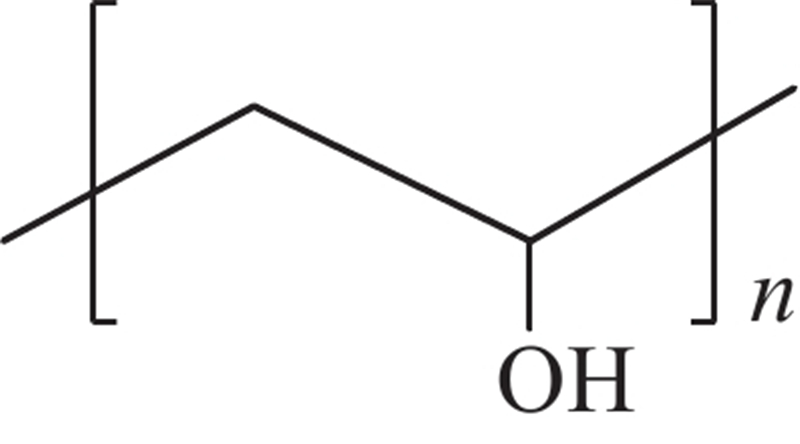 | 氢键 Hydrogen bond ( | 拉伸强度:36.5 MPa ,纵向应变:高达 ~ 438% Tensile strength: 36.5 MPa, longitudinal strain: as high as ~438% ( | 医学领域、柔性电子器件 In the medical field, ( flexible electronic devices ( |
| 聚丙烯酰胺 Polyacrylamide [(C3H5NO)n] | 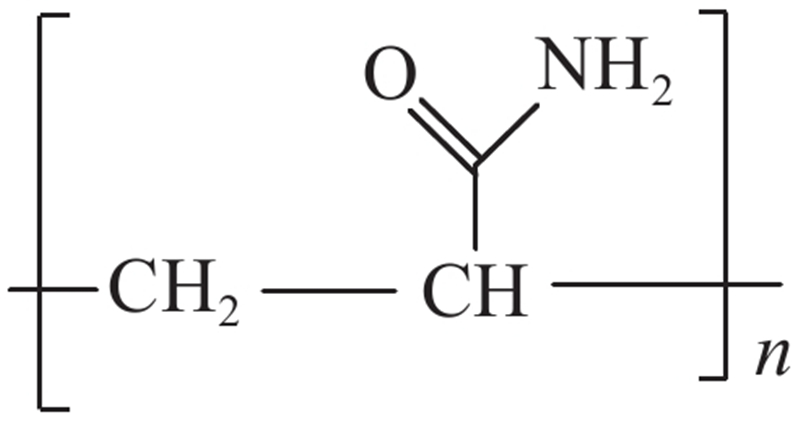 | 氢键 、酰胺键Hydrogen bond ( | 应变:高达 0~50%, 纵向拉伸强度:达36 MPa Strain: as high as 0–50%, ( longitudinal tensile strength: reaching 36 MPa ( | 软离子电子领域 Soft iontronics ( |
| 聚丙烯酸 Polyacrylic acid (C3H4O2) | 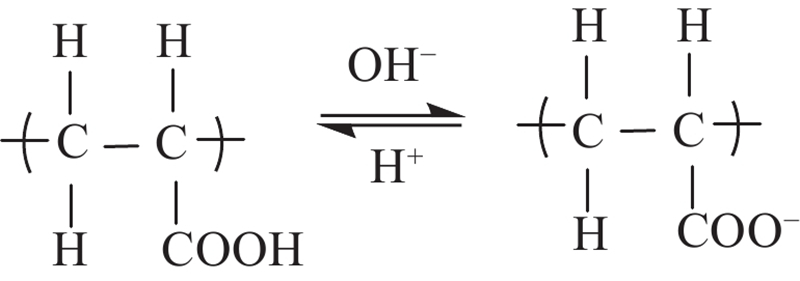 | 氢键、离子配位键(Al3+) Hydrogen bond, ionic coordination bond ( | 切向抗压强度:高达 1.73 MPa, 最大断裂应变: 69.4% Tangential compressive strength: as high as 1.73 MPa ( ( | 人机界面 Human-machine interface ( |
| 聚(N-异丙基丙烯酰胺) Poly(N-isopropylacrylamide)[(C6H11NO)n] | 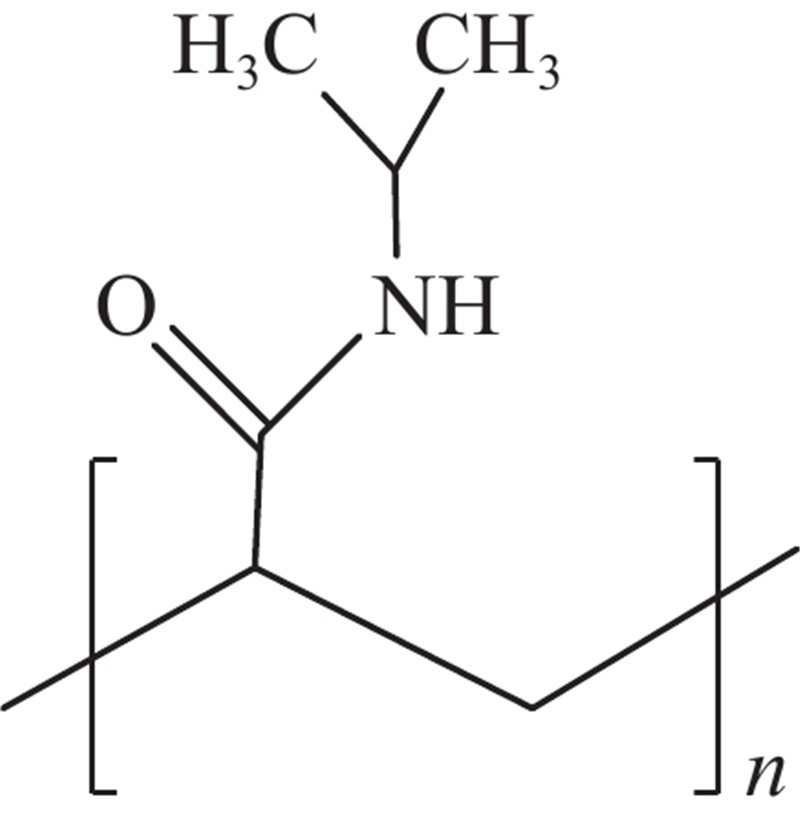 | 氢键 Hydrogen bond ( | 纵/横向拉伸强度: 317/ 152 kPa, 纵/横向杨氏模量: 5.4/0.31 MPa, 纵/横向韧性: 39.2/57.1 kJ·m?3 Longitudinal/transverse tensile strength: 317/152 kPa,longitudinal/transverse Young’s modulus:5.4/0.31 MPa,longitudinal/transverse toughness:39.2/57.1 kJ·m?3 ( | 光学应用 Optical applications ( |
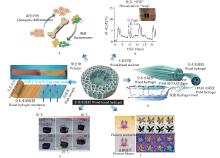
图4
木基水凝胶的应用 a. 人工骨膜 Artificial periosteum (Chen et al., 2022a) ;b. 人体刺激响应Human stimulation response (Yan et al., 2022);c. 高导电性木膜Highly conductive wood membrane (Chen et al., 2021a);d. 生物仿生组织Biomimetic tissue (Kong et al., 2018); e. 热响应驱动材料Thermal response driving material (Chen et al., 2022b);f. 光热转换材料Photothermal conversion material (Zhang et al., 2022b)."

| 蒋金成, 李 璟, 张镜元, 等. 油蜡热处理对木材物理性能及尺寸稳定性的影响. 森林工程, 2024, 40 (1): 106- 113. | |
| Jiang J C, Li J, Zhang J Y, et al. Effect of oil wax heat treatment on physical properties and dimensional stability of wood. Forest Engineering, 2024, 40 (1): 106- 113. | |
| 荆明星, 杨 宇, 付依扬, 等. 木材改良湿气发电机的设计及性能研究. 森林工程, 2023, 39 (6): 109- 115. | |
| Jing M X, Yang Y, Fu Y Y, et al. Design and performance study of wood-based moist-electric generator. Forest Engineering, 2023, 39 (6): 109- 115. | |
| 李 坚. 2014. 木材科学. 3版. 北京: 科学出版社. | |
| Li J. 2014. Wood science. 3rd ed. Beijing: Science Press. [in Chinese] | |
|
刘瑞雪, 陈纪超, 李迎博. 基于动态共价键和非共价键相互作用的自愈合水凝胶研究进展. 轻工学报, 2021, 36 (6): 110- 124.
doi: 10.12187/2021.06.013 |
|
|
Liu R X, Chen J C, Li Y B. Research progress of self-healing hydrogels based on dynamic covalent bond and non-covalent bond interaction. Journal of Light Industry, 2021, 36 (6): 110- 124.
doi: 10.12187/2021.06.013 |
|
|
Ajdary R, Tardy B L, Mattos B D, et al. Plant nanomaterials and inspiration from nature: water interactions and hierarchically structured hydrogels. Advanced Materials, 2021, 33 (28): 2001085.
doi: 10.1002/adma.202001085 |
|
|
Atalla R H, Hackney J M, Uhlin I, et al. Hemicelluloses as structure regulators in the aggregation of native cellulose. International Journal of Biological Macromolecules, 1993, 15 (2): 109- 112.
doi: 10.1016/0141-8130(93)90007-9 |
|
|
Chen C J, Kuang Y D, Zhu S Z, et al. Structure-property-function relationships of natural and engineered wood. Nature Reviews Materials, 2020, 5 (9): 642- 666.
doi: 10.1038/s41578-020-0195-z |
|
|
Chen G G, Li T, Chen C J, et al. Scalable wood hydrogel membrane with nanoscale channels. ACS Nano, 2021a, 15 (7): 11244- 11252.
doi: 10.1021/acsnano.0c10117 |
|
|
Chen C C, Wang Y R, Zhou T, et al. Toward strong and tough wood-based hydrogels for sensors. Biomacromolecules, 2021b, 22 (12): 5204- 5213.
doi: 10.1021/acs.biomac.1c01141 |
|
| Chen J Q, Chen J S, Zhu Z L, et al. Drug-loaded and anisotropic wood-derived hydrogel periosteum with super antibacterial, anti-inflammatory, and osteogenic activities. ACS Applied Materials & Interfaces, 2022a, 14 (45): 50485- 50498. | |
|
Chen L, Wei X S, Wang F, et al. In-situ polymerization for mechanical strong composite actuators based on anisotropic wood and thermoresponsive polymer. Chinese Chemical Letters, 2022b, 33 (5): 2635- 2638.
doi: 10.1016/j.cclet.2021.09.075 |
|
|
Cheng J, Jia Z, Li T. A constitutive model of microfiber reinforced anisotropic hydrogels: with applications to wood-based hydrogels. Journal of the Mechanics and Physics of Solids, 2020, 138, 103893.
doi: 10.1016/j.jmps.2020.103893 |
|
|
Correa S, Grosskopf A K, Lopez Hernandez H, et al. Translational applications of hydrogels. Chemical Reviews, 2021, 121 (18): 11385- 11457.
doi: 10.1021/acs.chemrev.0c01177 |
|
|
Engelund E T, Thygesen L G, Svensson S, et al. A critical discussion of the physics of wood-water interactions. Wood Science and Technology, 2013, 47 (1): 141- 161.
doi: 10.1007/s00226-012-0514-7 |
|
| Engelund E T. 2011. Wood-water interactions: Linking molecular level mechanisms with macroscopic performance. Kongens Lyngby: Technical University of Denmark. | |
| Gao C X, Gao Z C, Wei Y Q, et al. Flexible wood enhanced poly(acrylic acid-co-acrylamide)/quaternized gelatin hydrogel electrolytes for high-energy-density supercapacitors. ACS Applied Materials & Interfaces, 2023, 15 (2): 2951- 2960. | |
| Gao R N, Xiao S L, Gan W T, et al. Mussel adhesive-inspired design of superhydrophobic nanofibrillated cellulose aerogels for oil/water separation. ACS Sustainable Chemistry & Engineering, 2018, 6 (7): 9047- 9055. | |
|
Haq M A, Su Y L, Wang D J. Mechanical properties of PNIPAM based hydrogels: a review. Materials Science and Engineering, 2017, 70, 842- 855.
doi: 10.1016/j.msec.2016.09.081 |
|
| Hatakeyama H, Hatakeyama T. 2009. Lignin structure, properties, and applications//Biopolymers: lignin, proteins, bioactive nanocomposites. Heidelberg: Springer, 1−63. | |
|
Hu X Y, Ma Z W, Li J G, et al. Superior water anchoring hydrogel validated by colorimetric sensing. Materials Horizons, 2020, 7 (12): 3250- 3257.
doi: 10.1039/D0MH01383H |
|
|
Ibn Yaich A, Edlund U, Albertsson A C. Transfer of biomatrix/wood cell interactions to hemicellulose-based materials to control water interaction. Chemical Reviews, 2017, 117 (12): 8177- 8207.
doi: 10.1021/acs.chemrev.6b00841 |
|
|
Isogai A, Zhou Y X. Diverse nanocelluloses prepared from TEMPO-oxidized wood cellulose fibers: nanonetworks, nanofibers, and nanocrystals. Current Opinion in Solid State and Materials Science, 2019, 23 (2): 101- 106.
doi: 10.1016/j.cossms.2019.01.001 |
|
|
Jakes J E, Hunt C G, Zelinka S L, et al. Effects of moisture on diffusion in unmodified wood cell walls: a phenomenological polymer science approach. Forests, 2019, 10 (12): 1084.
doi: 10.3390/f10121084 |
|
|
Kaffashsaie E, Yousefi H, Nishino T, et al. Direct conversion of raw wood to TEMPO-oxidized cellulose nanofibers. Carbohydrate Polymers, 2021, 262, 117938.
doi: 10.1016/j.carbpol.2021.117938 |
|
|
Karaaslan M A, Tshabalala M A, Yelle D J, et al. Nanoreinforced biocompatible hydrogels from wood hemicelluloses and cellulose whiskers. Carbohydrate Polymers, 2011, 86 (1): 192- 201.
doi: 10.1016/j.carbpol.2011.04.030 |
|
|
Keplinger T, Cabane E, Berg J K, et al. Smart hierarchical bio-based materials by formation of stimuli-responsive hydrogels inside the microporous structure of wood. Advanced Materials Interfaces, 2016, 3 (16): 1600233.
doi: 10.1002/admi.201600233 |
|
|
Khodayari A, Thielemans W, Hirn U, et al. Cellulose-hemicellulose interactions: a nanoscale view. Carbohydrate Polymers, 2021, 270, 118364.
doi: 10.1016/j.carbpol.2021.118364 |
|
|
Kong W Q, Wang C W, Jia C, et al. Muscle-inspired highly anisotropic, strong, ion-conductive hydrogels. Advanced Materials, 2018, 30 (39): 1801934.
doi: 10.1002/adma.201801934 |
|
|
Li J Y, Ma E N. Characterization of water in wood by time-domain nuclear magnetic resonance spectroscopy (TD-NMR): a review. Forests, 2021, 12 (7): 886.
doi: 10.3390/f12070886 |
|
|
Li Y Y, Fu Q L, Rojas R, et al. Lignin-retaining transparent wood. ChemSusChem, 2017, 10 (17): 3445- 3451.
doi: 10.1002/cssc.201701089 |
|
|
Liu C, Li Y M, Hou Y. A simple environment-friendly process for preparing high-concentration alkali lignin nanospheres. European Polymer Journal, 2019, 112, 15- 23.
doi: 10.1016/j.eurpolymj.2018.12.031 |
|
| Liu J M, Wang D Q, Li Y Y, et al. Overall structure construction of an intervertebral disk based on highly anisotropic wood hydrogel composite materials with mechanical matching and buckling buffering. ACS Applied Materials & Interfaces, 2021, 13 (13): 15709- 15719. | |
|
Liu Z H, Li B Z, Yuan J S, et al. Creative biological lignin conversion routes toward lignin valorization. Trends in Biotechnology, 2022, 40 (12): 1550- 1566.
doi: 10.1016/j.tibtech.2022.09.014 |
|
| Lu Y, Gao R N, Xiao S L, et al. 2018. Cellulose based aerogels: processing and morphology//Biobased aerogels. Cambridge: Royal Society of Chemistry, 25−41. | |
|
Lu Y, Ma Y Y, Deng F, et al. Gradient wood-derived hydrogel actuators constructed by an isotropic-anisotropic structure strategy with rapid thermal-response, high strength and programmable deformation. Chemical Engineering Journal, 2025, 504, 158903.
doi: 10.1016/j.cej.2024.158903 |
|
|
Meier R J, Maple J R, Hwang M J, et al. Molecular modeling urea- and melamine-formaldehyde resins. 1. A force field for urea and melamine. The Journal of Physical Chemistry, 1995, 99 (15): 5445- 5456.
doi: 10.1021/j100015a030 |
|
| Nie K C, Wang Z S, Tang R X, et al. Anisotropic, flexible wood hydrogels and wrinkled, electrodeposited film electrodes for highly sensitive, wide-range pressure sensing. ACS Applied Materials & Interfaces, 2020, 12 (38): 43024- 43031. | |
|
Ouyang F Y, Wang W. Effect of thermo-hydro-mechanical treatment on mechanical properties of wood cellulose: a molecular dynamics simulation. Forests, 2022, 13 (6): 903.
doi: 10.3390/f13060903 |
|
| Pettersen R C. The chemical composition of wood. Advances in Chemistry Series, 1984, 207, 57- 126. | |
|
Potukuchi S, Chinthapenta V, Raju G. A review of NDE techniques for hydrogels. Nondestructive Testing and Evaluation, 2023, 38 (1): 1- 33.
doi: 10.1080/10589759.2022.2144304 |
|
| Pu Y Q, Zhang D C, Singh P M, et al. 2008. The new forestry biofuels sector. Biofuels, Bioproducts and Biorefining, 2(1): 58−73. | |
| Ratner B D, Latour R A. 2020. Role of water in biomaterials//Biomaterials science. Amsterdam: Elsevier, 77−82. | |
|
Rico-García D, Ruiz-Rubio L, Pérez-Alvarez L, et al. Lignin-based hydrogels: synthesis and applications. Polymers, 2020, 12 (1): 81.
doi: 10.3390/polym12010081 |
|
|
Sano K, Ishida Y, Aida T. Synthesis of anisotropic hydrogels and their applications. Angewandte Chemie International Edition, 2018, 57 (10): 2532- 2543.
doi: 10.1002/anie.201708196 |
|
|
Šebenik U, Lapasin R, Krajnc M. Rheology of aqueous dispersions of Laponite and TEMPO-oxidized nanofibrillated cellulose. Carbohydrate Polymers, 2020, 240, 116330.
doi: 10.1016/j.carbpol.2020.116330 |
|
| Siau J F. 1984. Transport processes in wood. Heidelberg: Springer-Verlag. | |
| Skaar C. 2012. Wood-water relations. Heidelberg: Springer Science & Business Media. | |
|
Stagno V, Ricci S, Longo S, et al. Discrimination between softwood and hardwood based on hemicellulose content obtained with portable nuclear magnetic resonance. Cellulose, 2022, 29 (14): 7917- 7934.
doi: 10.1007/s10570-022-04728-x |
|
|
Steck J, Kim J, Yang J W, et al. Topological adhesion. I. Rapid and strong topohesives. Extreme Mechanics Letters, 2020, 39, 100803.
doi: 10.1016/j.eml.2020.100803 |
|
| Steed J W, Atwood J L, Gale P A. 2012. Definition and emergence of supramolecular chemistry. Wiley: Chichester. | |
|
Thybring E E, Fredriksson M, Zelinka S L, et al. Water in wood: a review of current understanding and knowledge gaps. Forests, 2022, 13 (12): 2051.
doi: 10.3390/f13122051 |
|
|
Vigata M, Meinert C, Bock N, et al. Deciphering the molecular mechanism of water interaction with gelatin methacryloyl hydrogels: role of ionic strength, pH, drug loading and hydrogel network characteristics. Biomedicines, 2021, 9 (5): 574.
doi: 10.3390/biomedicines9050574 |
|
|
Wang G F, Liu Y, Zu B Y, et al. Reversible adhesive hydrogel with enhanced sampling efficiency boosted by hydrogen bond and van der Waals force for visualized detection. Chemical Engineering Journal, 2023, 455, 140493.
doi: 10.1016/j.cej.2022.140493 |
|
| Wang M H, Bai J Z, Shao K, et al. Poly(vinyl alcohol) hydrogels: the old and new functional materials. International Journal of Polymer Science, 2021, 2021, 2225426. | |
|
Wang W, Zhang Y Y, Liu W G. Bioinspired fabrication of high strength hydrogels from non-covalent interactions. Progress in Polymer Science, 2017, 71, 1- 25.
doi: 10.1016/j.progpolymsci.2017.04.001 |
|
|
Wang Y S, Wang J L, Ling S J, et al. Wood-derived nanofibrillated cellulose hydrogel filters for fast and efficient separation of nanoparticles. Advanced Sustainable Systems, 2019, 3 (9): 1900063.
doi: 10.1002/adsu.201900063 |
|
|
Wang S N, Chen H, Li K, et al. Strong, transparent, and thermochromic composite hydrogel from wood derived highly mesoporous cellulose network and PNIPAM. Composites Part A: Applied Science and Manufacturing, 2022a, 154, 106757.
doi: 10.1016/j.compositesa.2021.106757 |
|
|
Wang Y L, Gui C J, Wu J Y, et al. Spatio-temporal modification of lignin biosynthesis in plants: a promising strategy for lignocellulose improvement and lignin valorization. Frontiers in Bioengineering and Biotechnology, 2022b, 10, 917459.
doi: 10.3389/fbioe.2022.917459 |
|
|
Wang Z X, Zhou Z J, Wang S J, et al. An anti-freezing and strong wood-derived hydrogel for high-performance electronic skin and wearable sensing. Composites Part B: Engineering, 2022c, 239, 109954.
doi: 10.1016/j.compositesb.2022.109954 |
|
|
Xue B, Qin M, Wang T K, et al. Electrically controllable actuators based on supramolecular peptide hydrogels. Advanced Functional Materials, 2016, 26 (48): 9053- 9062.
doi: 10.1002/adfm.201603947 |
|
|
Yan G H, He S M, Chen G F, et al. Highly flexible and broad-range mechanically tunable all-wood hydrogels with nanoscale channels via the hofmeister effect for human motion monitoring. Nano-Micro Letters, 2022, 14 (1): 84.
doi: 10.1007/s40820-022-00827-3 |
|
|
Youssefian S, Jakes J E, Rahbar N. Variation of nanostructures, molecular interactions, and anisotropic elastic moduli of lignocellulosic cell walls with moisture. Scientific Reports, 2017, 7, 2054.
doi: 10.1038/s41598-017-02288-w |
|
|
Zhang X J, Xiang J X, Hong Y L, et al. Recent advances in design strategies of tough hydrogels. Macromolecular Rapid Communications, 2022a, 43 (15): 2200075.
doi: 10.1002/marc.202200075 |
|
|
Zhang D T, Yang K, Liu X Y, et al. Boosting the photothermal conversion efficiency of MXene film by porous wood for light-driven soft actuators. Chemical Engineering Journal, 2022b, 450, 138013.
doi: 10.1016/j.cej.2022.138013 |
|
|
Zhang Z C, Yu C Y, Peng Z Y, et al. Mechanically stiff and high-areal-performance integrated all-in-wood supercapacitors with electroactive biomass-based hydrogel. Cellulose, 2021, 28 (1): 389- 404.
doi: 10.1007/s10570-020-03509-8 |
|
|
Zhao X J, Liang Z W, Huang Y B, et al. Influence of phytic acid on flame retardancy and adhesion performance enhancement of poly (vinyl alcohol) hydrogel coating to wood substrate. Progress in Organic Coatings, 2021, 161, 106453.
doi: 10.1016/j.porgcoat.2021.106453 |
|
|
Zhou Y, Jin L H. Hydrolysis-induced large swelling of polyacrylamide hydrogels. Soft Matter, 2020, 16 (24): 5740- 5749.
doi: 10.1039/D0SM00663G |
|
|
Zhou Y, Liu J M, Li H, et al. Molecular recognition of the self-assembly mechanism of glycosyl amino acetate-based hydrogels. ACS Omega, 2021, 6 (33): 21801- 21808.
doi: 10.1021/acsomega.1c03510 |
|
|
Zhu H L, Luo W, Ciesielski P N, et al. Wood-derived materials for green electronics, biological devices, and energy applications. Chemical Reviews, 2016, 116 (16): 9305- 9374.
doi: 10.1021/acs.chemrev.6b00225 |
| [1] | 祝亚, 伍希志, 黄渊硕. 基于局部自相关函数熵的木材砂光表面粗糙度视觉检测方法[J]. 林业科学, 2025, 61(5): 199-206. |
| [2] | 李钦渊, 周泽园, 李廷山, 于海群, 赵洪贤, 刘新月, 高瑶, 刘鹏, 查天山. 北京百花山华北落叶松天然次生林的资源利用效率生长季动态变化及影响因素[J]. 林业科学, 2025, 61(4): 69-80. |
| [3] | 杨世纪,万艳芳,白雨诗,王冬梅,于澎涛,王彦辉,王巍樾,陈瑜佳. 六盘山不同坡向华北落叶松林分蒸腾对环境因子的响应[J]. 林业科学, 2025, 61(3): 108-120. |
| [4] | 郭娟, 焦立超, 何拓, 马灵玉, 姜笑梅, 殷亚方. 木材定量解剖研究新进展[J]. 林业科学, 2025, 61(2): 204-218. |
| [5] | 陈炎,孟素戎,黄安民,苏莹莹,孙柏玲. 三聚氰胺-尿素-乙二醛树脂浸渍改性对人工林红锥木材物理力学性能的影响[J]. 林业科学, 2025, 61(1): 166-175. |
| [6] | 谢静,张峰,周泽圆,于海群,韩艺,杨春欣,蒋薇,刘进祖,刘博恩,刘鹤. 北京城市公园人工林生态系统水分利用效率的季节变化[J]. 林业科学, 2024, 60(9): 12-17. |
| [7] | 竹万宽,王志超,杜阿朋,许宇星. 广东湛江桉树人工林碳水通量季节格局及其环境生物控制[J]. 林业科学, 2024, 60(9): 18-32. |
| [8] | 朱铭玮,赵薇,付威,高云鹏,王文武,解志军,李淑娴. 国槐种子成熟过程及其水分时空变化[J]. 林业科学, 2024, 60(9): 41-49. |
| [9] | 都亚敏,李珠,蒋佳荔,殷方宇,吕建雄. 吸湿解吸循环过程中木材水分吸附特性[J]. 林业科学, 2024, 60(9): 150-158. |
| [10] | 韩刘杨,郭娟,韩向娜,席光兰,田兴玲,李仁,陈家宝,殷亚方. 饱水考古木材保存状况评估研究进展[J]. 林业科学, 2024, 60(9): 183-198. |
| [11] | 王一君,陈立欣,陈左司南,张志强,许行,姚飞,陈胜楠. 夜间不同环境稳定性条件下杨树水分生理过程的生物物理控制[J]. 林业科学, 2024, 60(8): 95-108. |
| [12] | 王傲宇,郭有正,邓坦,刘洋,邸楠,段劼,李熙萌,席本野. 几种评价植物水分调节策略的方法对比——以毛白杨为例[J]. 林业科学, 2024, 60(8): 109-119. |
| [13] | 管崇帆,高翔,李志鹏,胡晓创,胡美均,张劲松,孟平,蔡金峰,孙守家. 辽西地区樟子松人工林生产力和水分利用效率对气候变化的响应及预测[J]. 林业科学, 2024, 60(7): 28-39. |
| [14] | 袁鸣,朱铭玮,解志军,康真,李淑娴. 沼生栎种子失水过程中水分时空迁移规律[J]. 林业科学, 2024, 60(6): 44-49. |
| [15] | 杨春梅,刘彤彬,马亚强,丁禹程,王金聪,胡松,宋文龙. 基于响应曲面法的木材喷涂漆雾扩散角度与均匀度优化[J]. 林业科学, 2024, 60(6): 136-147. |
| 阅读次数 | ||||||
|
全文 |
|
|||||
|
摘要 |
|
|||||